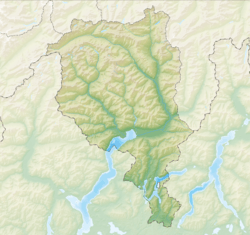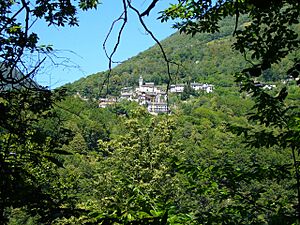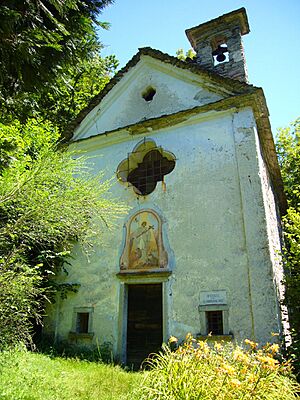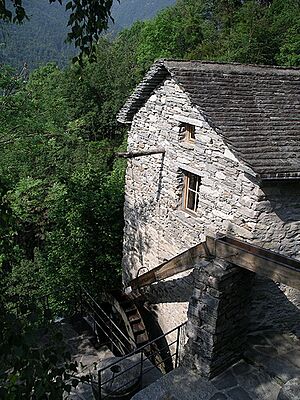Isorno facts for kids
Quick facts for kids
Isorno
|
||
|---|---|---|
 |
||
|
||
| Country | Switzerland | |
| Canton | Ticino | |
| District | Locarno | |
| Area | ||
| • Total | 17.1 km2 (6.6 sq mi) | |
| Elevation | 678 m (2,224 ft) | |
| Population
(December 2004)
|
||
| • Total | 341 | |
| • Density | 19.94/km2 (51.65/sq mi) | |
| Postal code |
6661
|
|
| Localities | Auressio, Berzona, Loco, Niva, Rossa, Seghellina | |
| Surrounded by | Cavigliano, Intragna, Maggia, Mosogno, Onsernone | |
Isorno was once a small town, or municipality, in the Locarno area of Ticino, a canton in Switzerland. It was located in the beautiful Onsernone valley, near the Isorno river.
In 2016, Isorno joined with a few other nearby towns: Vergeletto, Gresso, Mosogno, and Onsernone. Together, they now form the larger municipality of Onsernone. Before that, in 2001, Isorno itself was created when three smaller villages – Auressio, Berzona, and Loco – decided to merge.
Contents
History of Isorno's Villages
The villages that made up Isorno have a long history. Auressio was first mentioned in records way back in 1233. Berzona appeared in records in 1265, and Loco was first noted in 1224.
Auressio's Past
For a long time, Auressio had stronger connections with Piedmont (a region in Italy) than with the rest of the Onsernone valley. This changed in the 1800s when a road was built through the valley. This road made it easier for Auressio to connect with its Swiss neighbors.
The local church, S. Antonio Abate, was finished in 1526. It became its own independent church area, called a parish, in 1792, separating from Loco.
After World War II, fewer people worked in farming or raising animals. Instead, many people left for short periods to work elsewhere. As transport to the nearby city of Locarno got better, more people chose to live in Auressio and work in Locarno. This has made the population of Auressio grow in recent years.
A special building in Auressio is the Villa Edera, built in 1887. It was originally for a famous show organizer from Paris. In the 1990s, the town fixed it up, and now it's used as a hostel where people can stay.
Berzona's Story
Berzona has a part called Seghelina right on the main road, but the main village is higher up. In the Middle Ages, Berzona was part of a larger group of villages in Onsernone.
The church of S. Defendente was built in 1564. It became a separate parish church from Loco in 1777. Seghelina also has two small chapels, Santa Maria (built 1682) and S. Maria Lauretana (built 1766). Berzona became its own political town in 1803, when the Canton of Ticino was created.
After World War II, many people moved away from Berzona. They often sold their homes to people from outside the village. Many famous artists and writers, like Alfred Andersch, Golo Mann, and Max Frisch, bought houses here. Today, the village is getting smaller. There are not many farming jobs left, so most working people have moved to Locarno.
Loco's Importance
Loco also included the small villages, or hamlets, of Niva and Rossa.
From the Middle Ages until the late 1700s, Loco was the main town of the old Onsernone valley community.
The main church, San Remigio, was the most important church in the valley. It was first mentioned in 1228 but is probably even older. In the early 1500s, it was rebuilt and got its current bell tower. Inside, there's a special chapel with an old, respected cross. The church also has a painting of the Last Supper by a Flemish artist named Godefridus Maes from 1683. In Niva, there's a beautiful old chapel dedicated to St. John Nepomuk.
In the 1800s, Loco was a busy place for straw braiding. People made hats, bags, and other items from straw. The straw braids themselves were made in other villages in the Onsernone valley.
Loco has many traditional houses with balconies, and also some grand old mansions. One example is the Casa Broggini, built in 1708, located in Rossa.
The main primary school for the area is in Loco. You can also find the Onsernonese Museum there, which opened in 1966. Near Loco, there's a restored old mill that now has an exhibition about how grain was milled in the past. Casa Shira, a 19th-century building, has a small public library and a hostel.
By the early 2000s, most people living in Loco traveled to Locarno for work.
Geography of Isorno
Isorno covered an area of about 17.1 square kilometers (about 6.6 square miles). A small part of this land, about 8.4%, was used for farming. A large part, 73.2%, was covered by forests. Only a small amount, 0.9%, had buildings or roads. The remaining 17.5% was land that couldn't be used for farming or building, like rocky areas.
The former municipality was located in the Locarno district, within the Onsernone valley. It was nestled along the Isorno river and included the villages of Auressio, Berzona, and Loco.
Isorno's Coat of Arms
The coat of arms for Isorno has a blue top and a green bottom. A wavy silver line separates these two parts. Overlaid on top are three golden ribbons woven together, meeting at the top. This new coat of arms was designed to show that the three villages (Auressio, Berzona, and Loco) merged, with each ribbon representing one of the original towns.
People of Isorno (Demographics)
In 2014, Isorno had a population of 317 people. About 11.1% of the people living there in 2008 were foreign nationals, meaning they were not Swiss citizens. Over ten years, from 1997 to 2007, the population decreased by about 6.5%.
Most people in Isorno (70%) spoke Italian in 2000. German was the second most common language (20.9%), and French was third (8.0%).
In 2008, about 48.7% of the population were male and 51.3% were female. This included Swiss citizens and non-Swiss residents.
The age groups in Isorno in 2009 were:
- Children (0-9 years old): 31 people (8.8%)
- Teenagers (10-19 years old): 28 people (8.0%)
- Young adults (20-29 years old): 31 people (8.8%)
- Adults (30-39 years old): 40 people (11.4%)
- Adults (40-49 years old): 51 people (14.5%)
- Adults (50-59 years old): 70 people (19.9%)
- Seniors (60-69 years old): 44 people (12.5%)
- Seniors (70-79 years old): 27 people (7.7%)
- Seniors (over 80 years old): 29 people (8.3%)
Economy of Isorno
In 2007, the unemployment rate in Isorno was 2.45%, meaning a small number of people who wanted jobs couldn't find them.
In 2005, there were 14 people working in the primary economic sector (like farming or forestry) across 7 businesses. Five people worked in the secondary sector (like manufacturing or construction) in 3 businesses. The largest number of workers, 58 people, were in the tertiary sector (like services, shops, or tourism) across 13 businesses.
About 6.3% of working people used public transport to get to their jobs, while 47.2% used a private car. In 2009, Isorno had 2 hotels.
Historic Population Data
Here's how the population of Auressio, Berzona, and Loco changed over time:
| Year | Population Auressio |
Population Berzona |
Population Loco |
|---|---|---|---|
| 1795 | 240 | 306 | 684 |
| 1808 | 273 | 286 | 689 |
| 1850 | 198 | 235 | 600 |
| 1900 | 164 | 151 | 402 |
| 1950 | 76 | 84 | 258 |
| 2000 | 71 | 48 | 254 |
Important Heritage Sites
The Museo Onsernonese (Onsernone Museum) is considered a very important cultural site in Switzerland. It's listed as a heritage site of national significance. Also, the entire villages of Auressio, Berzona, and Loco are recognized as important Swiss heritage sites.
Education in Isorno
In Switzerland, most people are well-educated. In Isorno, about 64.1% of adults (aged 25 to 64) had completed either high school or gone on to higher education, like university.
In 2009, there were 46 students in Isorno. The education system in Ticino offers up to three years of optional kindergarten. In Isorno, 10 children were in kindergarten. The primary school program lasts for five years, and 14 students attended these schools.
For lower secondary school, students can choose between a two-year middle school followed by a two-year pre-apprenticeship, or a four-year program to prepare for university. In Isorno, 14 students were in the two-year middle school program.
Upper secondary school prepares students for a trade or for university. In Ticino, students can learn a trade while doing an internship or apprenticeship. In Isorno, 5 students were full-time vocational students, and 3 were part-time.
Images for kids
See also
 In Spanish: Isorno para niños
In Spanish: Isorno para niños











